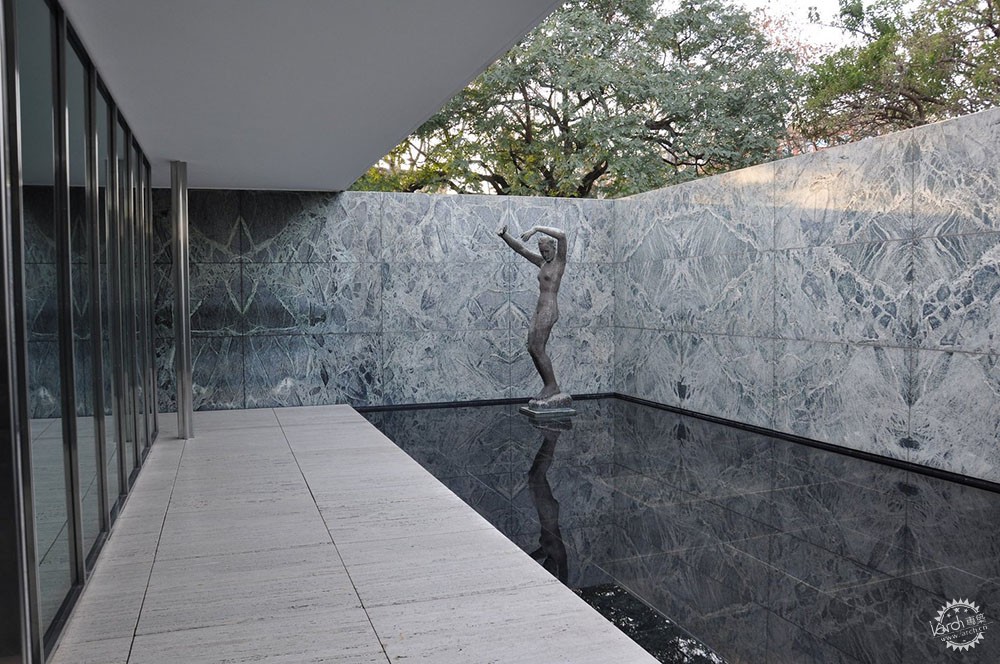
Barcelona Pavilion. @ Flickr Renato Saboya. Used under Creative Commons
现代主义中艺术与建筑的密切关系
The Close Relationship Between Art and Architecture in Modernism
由专筑网邢子,小R编译
艺术和建筑之间融合的想法可以追溯到该学科的起源,然而,在二十世纪初的运动中,它有了新的意义和社会目的,成为现代主义最明确的特征。这种密切关系在一些伟大的现代建筑师的作品中显而易见,如密斯、柯布西耶和尼迈耶等大师的作品。
不用说,现代主义是从对被战争破坏的世界的道德和物质重建的期望中产生的,它作为一种工具,加强了集体认同感,从而加强了城市和居民之间的联系。在这种情况下,艺术表达被用作塑造用户情感生活的工具,艺术和建筑的结合可以赋予其新的意义,提供一个除了功能和技术之外,还代表社区感的地方。
包豪斯的专业发展以Argan(1992)所说的“方法论-教条理性主义”为标志,鼓励通过Gesamtkunstwerk来统一所有的艺术,这大概可以翻译为“整体艺术作品”,包括建筑、绘画、雕塑、工业设计和工艺。这种合作甚至有望出现在建筑工地上,从而将设计和手工工作结合起来,形成一种共同的经验。正如他们的主要倡导者沃尔特-格罗皮乌斯所言,建筑师应该像画家一样熟悉绘画,也应该熟悉建筑,不应该设计一座建筑之后另外委托一个雕塑家,这是错误的,这有损于建筑的统一性。
除了包豪斯计划,这种学科间的整合也是由柯布西耶通过将绘画和雕塑的元素与建筑的形式概念相结合而提出的,是最引人注目的。在这个意义上,尽管柯布西耶扮演的是一个“独角戏”,在他的设计中宣扬艺术的综合,但他总是作为一个单独的艺术家在工作。他认为建筑师、画家和雕塑家的角色是同等重要的,有助于在现实世界中,即在建筑工地上,通过创造和设计完全和谐地进行生产合作。
在某种程度上,这种不可分割的关系听起来是如此的乌托邦,以至于Lucio Costa说,这种更伟大的艺术需要一种几乎不可能实现的文化和美学进化水平,在这种情况下,建筑、雕塑和绘画将形成一个凝聚体,一个不能被瓦解的活的有机体。里约热内卢的卡帕内玛宫可以说是在巴西最接近这种乌托邦的地方,它从项目开发的一开始就依靠画家Candido Portinari、雕塑家Bruno Giorgi和景观设计师Burle Marx。正如法国历史学家Yves Bruand所说,其结果是一个具有巨大艺术价值的集合体,出色地加强和补充了建筑,但同时又从属于建筑。
The idea of integration between art and architecture dates back to the very origin of the discipline, however, it took on a new meaning and social purpose during the Avant-Garde movement of the early twentieth century, becoming one of the most defining characteristics of Modernism. This close relationship is evident in the works of some of the greatest modern architects, such as Mies van der Rohe, Le Corbusier, and Oscar Niemeyer, to name a few.
Needless to say, modernism emerged from an expectation of moral and material reconstruction of a world devastated by war, serving as a tool to strengthen a collective identity and, consequently, the bond between the city and its inhabitants. In this context, artistic expression is used as a tool to shape the emotional life of the user, to which art and architecture combined can give a new meaning, offering a place that represents a sense of community, in addition to function and technique.
The professional development at Bauhaus was marked by what Argan (1992) calls "methodological-didactic rationalism," encouraging the unification of all the arts through a Gesamtkunstwerk, which roughly translates as a "total work of art," incorporating architecture, painting, sculpture, industrial design, and crafts. This collaboration was expected to happen even on the building site, thus bringing together intellectual and manual work in a shared experience. As their leading exponent Walter Gropius used to say, an architect should be as familiar with painting as a painter should be with architecture. One should not design a building and commission a sculptor afterward; this would be wrong and detrimental to the architectural unity.
Apart from the Bauhaus program, this integration between disciplines was also, and most notably, brought up by Le Corbusier through the combination of elements from painting and sculpture with the formal concepts of architecture. In this sense, Le Corbusier - despite being a "one-man show" who preached the synthesis of the arts in his designs, but always worked as a solo artist - argued that the roles of architects, painters, and sculptors were of equal importance contributing to productive collaborations in the real world, that is, on the building site, by creating and designing in complete harmony.
To some extent, this inseparable relationship sounded so utopian that Lucio Costa stated that this greater art would require a level of cultural and aesthetical evolution that was almost impossible to achieve, in which architecture, sculpture, and painting would form one cohesive body, a living organism that could not be disintegrated. Nevertheless, the Capanema Palace in Rio de Janeiro is arguably the closest one could get to this utopia in Brazil by relying on painter Candido Portinari, sculptor Bruno Giorgi and landscape architect Burle Marx from the very beginning of the project development. As French historian Yves Bruand states, the result is an ensemble of great artistic value, brilliantly enhancing and complementing architecture, but subordinated to it at the same time.
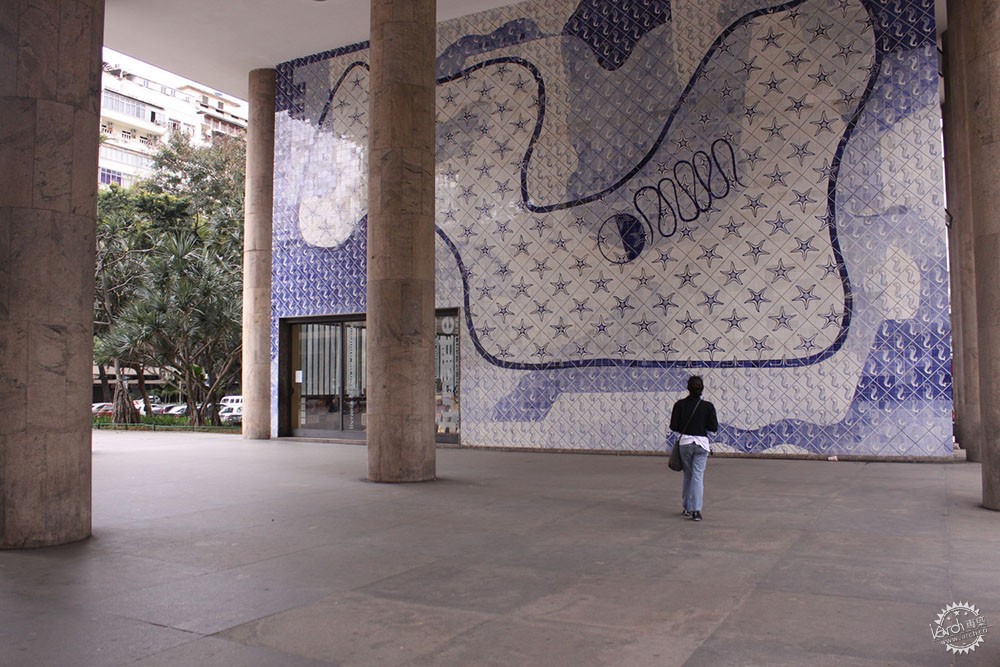
AD Classics: Ministry of Education and Health Building / Lucio Costa e equipe. © Marina de Holanda
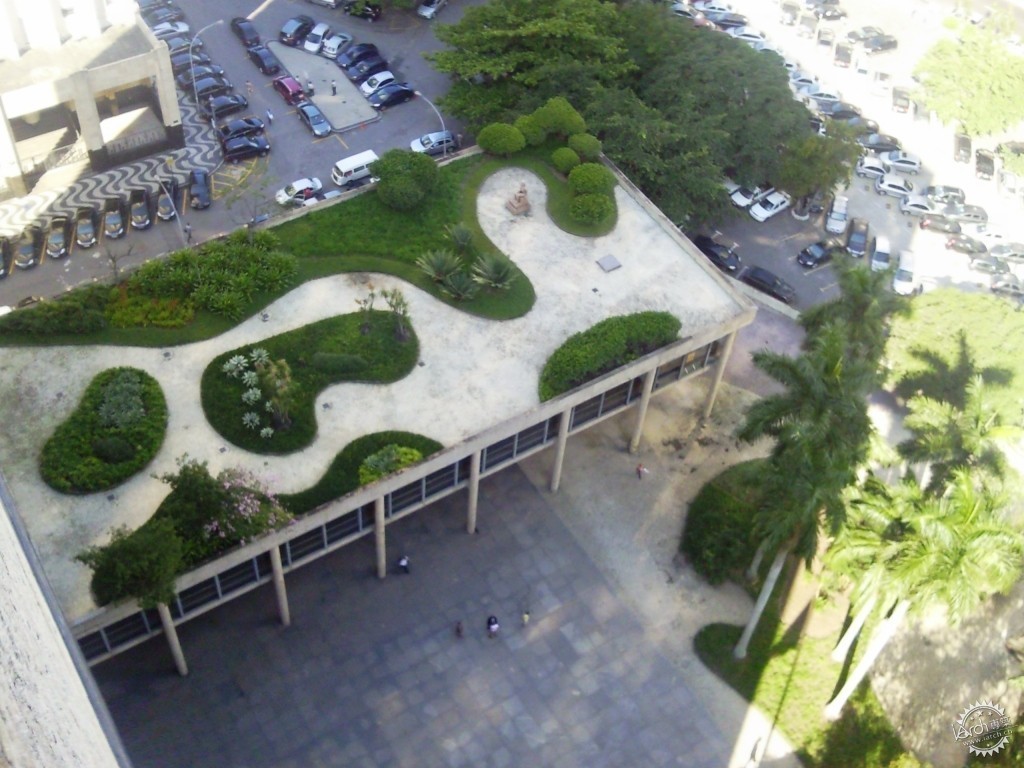
Gardens of the Gustavo Capanema Palace. © Flickr jcoarq. Used under Creative Commons
虽然他的作品被证明是建筑和艺术融合的最佳范例,但尼迈耶也赞同Costa的观点,即只有在特殊情况下才能实现艺术的真正综合。他还强调了建立一个团队的重要性,这个团队从建筑草图的一开始就一起工作,协作讨论项目的问题和细节,不把它们分成专门的领域,而是把它们看作一个单一的平衡实体。
理想的目标是在项目开始时就整合所有的学科,但是邀请艺术家在设计过程的后期参与并不一定会影响最终的结果。一个很好的例子是巴西利亚国民议会的Salão Negro(黑屋),艺术家Athos Bulcão在项目完成后受到尼迈耶的邀请,用地面上的黑色花岗岩和墙上的白色大理石创造了一种抽象而简单的语言,这使得壁画与建筑和建筑材料完全融合。这种带有抽象图案的壁画经常被学术界引用,包括Paul Damaz,他说非具象的语言是与现代建筑最匹配的。在这方面,作者还提到了Maria Martins在阿尔沃拉达宫花园中的半具象青铜雕塑,强调了雕塑的"形式上的亲和力"和"建筑的优美柱式",这是一个完美的融合例子。
While his works turned out to be prime examples of the fusion of architecture and art, Oscar Niemeyer also shared Costa's opinion that only in extraordinary circumstances could a true synthesis of the arts be achieved. He also stressed the crucial need to establish a team that would work together from the very beginning of the architectural sketches to amicably discuss the problems and smallest details of the project, without dividing them into specialized fields but considering them as a single balanced entity.
The ideal goal is to integrate all disciplines from the beginning of the project, but inviting artists to participate later in the design process does not necessarily compromise the final result. A good example is the Salão Negro (Black Room) at the National Congress in Brasília, where artist Athos Bulcão, invited by Niemeyer after the project was finished, created an abstract and simple language using black granite on the floor and white marble on the walls, which resulted in a mural fully integrated with the architecture and building materials. This mural with abstract patterns is often cited by academics, including Paul Damaz when he states that non-figurative language is the best match for modern architecture. In this regard, the author also mentions Maria Martins' semi-figurative bronze sculpture in the gardens of the Palácio da Alvorada, highlighting the "formal affinity between the curves" of the sculpture and the "graceful pillars of the building," as a perfect example of integration.
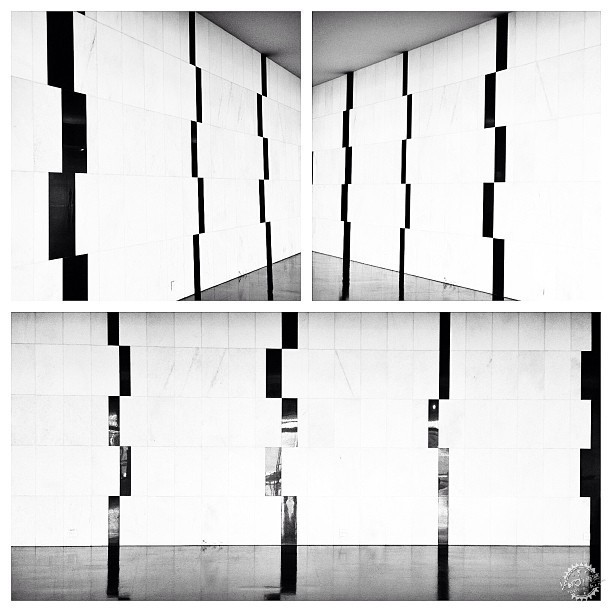
Mural in the Nation Congress in Brasília. @ Flickr genciasenado. Used under Creative Commons
然而,尽管Damaz赞扬了尼迈耶项目中建筑与艺术的融合,但他却拒绝了现代主义历史上学科间融合的最重要的例子之一,那就是墨西哥城的UNAM校园。这个建筑群是墨西哥最具代表性的建筑成就之一,这个国家被认为是将艺术融入建筑的先驱,从他们自20世纪20年代以来的壁画传统中可以看出。该大学校园于1952年落成,与CIAM第八届会议并行,由100多位建筑师以及工程师、艺术家和景观设计师设计。该项目中最引人注目的一些艺术作品是Diego Rivera、David Alfaro Siqueiros、Juan O'Gorman,以及Francisco Eppens的壁画,这些壁画被作者批评为具象的,在社会现实主义和功能主义建筑之间造成了风格上的不一致,对后者不利。然而,尽管有这些批评,人们不能忽视UNAM是一个露天艺术博物馆,是合作和集体主义的典范。
However, while Damaz praises the integration between architecture and art in Oscar Niemeyer's projects, he rejects one of the most important examples of integration between disciplines in the history of modernism, which is Mexico City's UNAM Campus. This complex is one of the most emblematic architectural achievements in Mexico, a country considered to be a pioneer in the incorporation of art into architecture, as seen in their tradition of mural painting since the 1920s. Inaugurated in 1952, parallel to the CIAM VIII, the University Campus was designed by more than 100 architects, as well as engineers, artists, and landscape designers. Some of the most remarkable artworks featured in the project are the murals by Diego Rivera, David Alfaro Siqueiros, Juan O'Gorman, and Francisco Eppens, which were criticized by the author for being figurative, creating a disparity in style between social realism and functionalist architecture, to the detriment of the latter. Nevertheless, despite the critiques, one cannot ignore the fact that UNAM is an open-air art museum and an example of cooperation and collectivity.
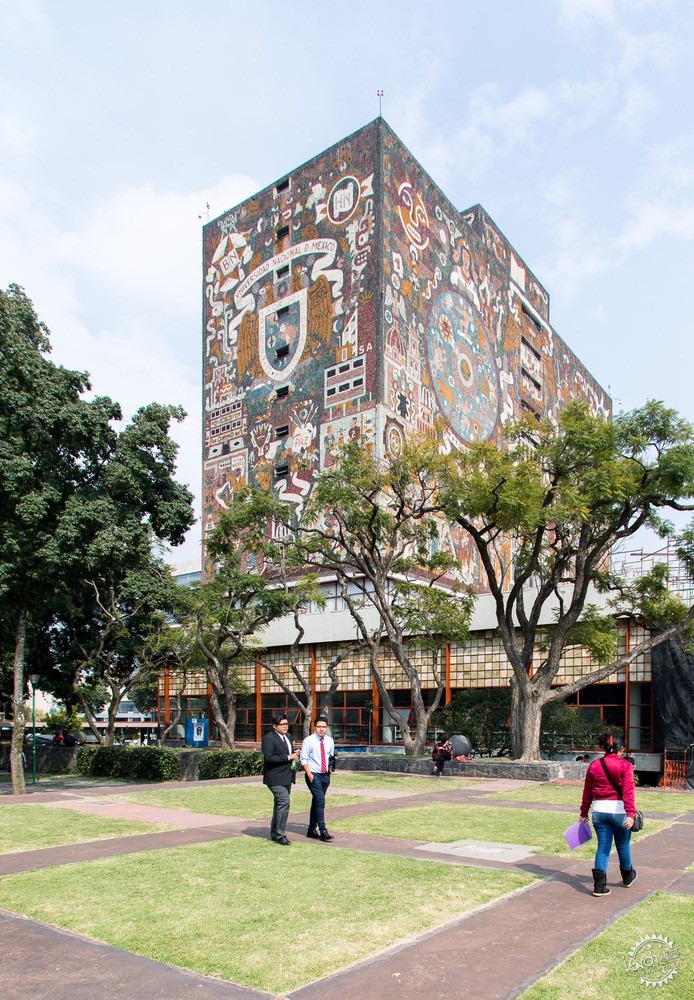
Photographer Yueqi “Jazzy” Li Captures the Dynamism of Mexico City's UNAM Campus. © Yueqi "Jazzy" Li
虽然规模不同,但同样重要的是,通过纳入偶尔的个别元素,如密斯的标志性巴塞罗那馆,实现了艺术与建筑之间的整合。的确,德国雕塑家Georg Kolbe(1877-1947)的雕塑《Der Morgen》,也被称为《Alba》,对展馆来说并非必不可少,但是,在这个新的建筑概念中,如果不仅仅是平面和垂直支撑的安排,又有什么是必不可少的?该馆完全独立于雕塑以及材料,然而,如果没有这个伸出双臂的人形,人们今天就无法想象它是如何为用户的空间体验准确定位和构架的。正如Claudia Cabral所解释的,“在密斯的微妙平衡中,在部分不对称和补偿系统的引导下,雕塑是唯一没有对应的元素[...]密斯决定只放置一个雕塑,在他的抽象平面中放置一个单一的形象元素。在展馆的反射、透明和平行游戏中,我们是铜像唯一可能的伙伴,我们是有血有肉的人类,是参观者。”
On a different scale but equally important, is integration between art and architecture through the inclusion of occasional individual elements such as the iconic Barcelona Pavilion by Mies van der Rohe. Indeed, the sculpture Der Morgen, also known as Alba, by German sculptor Georg Kolbe (1877-1947) is not essential to the pavilion. But what else is essential in this new architectural concept, if not only the arrangement of planes and vertical supports? The pavilion is completely independent of the sculpture, as well as of the materials however, one cannot picture it today without this human figure with arms outstretched precisely positioned and framed for the user's experience. As Claudia Cabral beautifully explains, "in Mies' delicate balance, guided by partial asymmetries, and by a system of compensations, the sculpture is the only element that has no counterpart [...] Mies decided to place only one sculpture, a single figurative element in his abstract plane. Within the pavillions play with reflections, transparency, and parallels, we are the only possible partners for the bronze figure, we humans of flesh and blood, the visitors."

Barcelona Pavilion. @ Commons Wikimedia Rodrigo Pereira da Silva. Used under Creative Commons
不同学科的每一种整合形式都包括建筑师、画家和雕塑家之间的一致对话,无论是从项目开发的一开始还是后来的施工过程中,无论是大规模的还是单个元素的。考虑到这一点,目睹2009年艺术家Athos Bulcão在巴西利亚的Planalto Palace的展板因翻新而被迁移等事件是非常令人震惊和遗憾的,甚至Athos Bulcão基金会也反对这样做,因为原来的位置是由Athos本人和尼迈耶在1950年设计这座建筑时确定的。
Every form of integration of different disciplines consists of a coherent dialogue between architects, painters, and sculptors, whether from the very beginning of the project development or later on, during construction, whether on a large scale or with individual elements. Having this in mind, it is very alarming to witness events such as the relocation of the panels by artist Athos Bulcão in the Planalto Palace in Brasilia in 2009 due to a renovation. Even the Athos Bulcão Foundation - Fundathos opposed it since the original location was defined by Athos himself, along with Niemeyer while he was designing the palace in 1950.
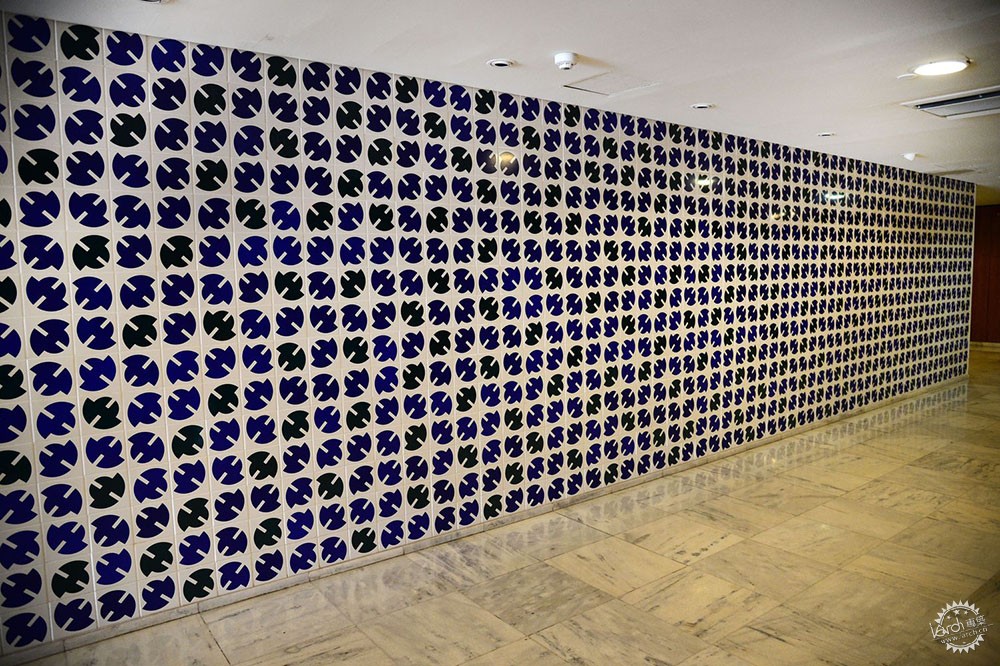
Mural by Athos Bulcão at Planalto Palace. @ Commons Wikimedia Agência Brasil. Used under Creative Commons
正如Rino Levi曾经所说,建筑不是次要的,但也不是所有艺术之母。只有一种艺术,其价值是由它在我们身上引发的情感来衡量。绘画和雕塑可以是独立的,然而,当它们应用于建筑时,它们就成了整体的一部分。这种关于集体性和共享经验的过程在项目开发期间就开始了,联系并触动着每一个有机会参观建筑作品的人。
As Rino Levi once said, architecture is not secondary, but neither is it the mother of all arts. There is only one art and its value is measured by the emotions it triggers in us. Painting and sculpture can be independent, however, when applied to architecture, they become part of a whole. This lesson on collectivity and shared experiences starts during project development and touches every single person who has the opportunity to visit the architectural work.
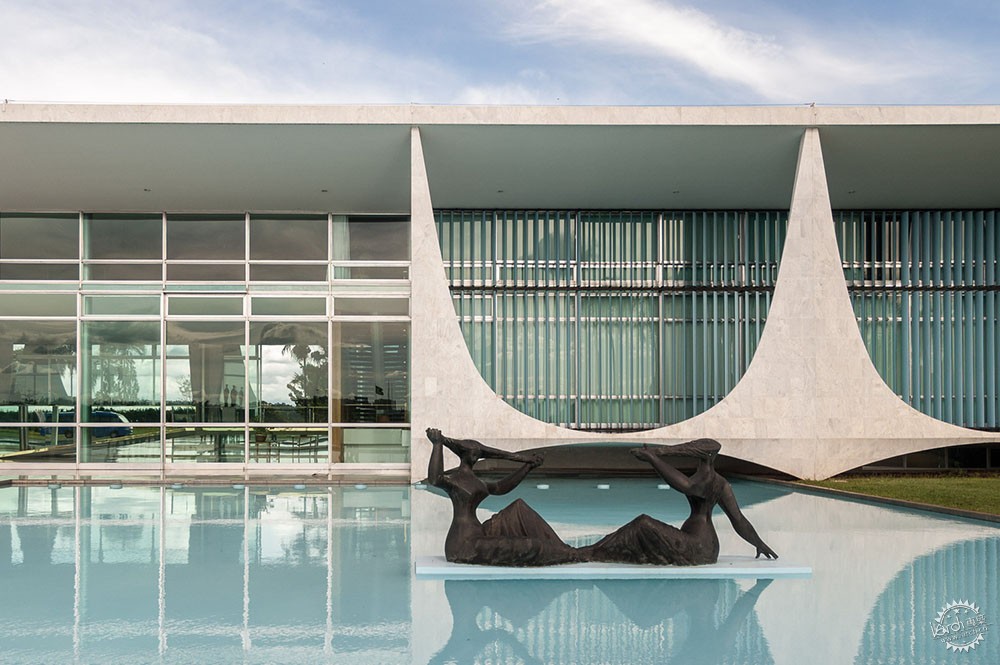
Palácio da Alvorada through the eyes of Joana França. © Joana França
Reference List
ARGAN, Giulio Carlo. Arte Moderna [Modern art]. São Paulo: Cia das Letras, 1992.
BRUAND, Yves. Arquitetura contemporanea no Brasil. São Paulo: Perspectiva, 2010.
CABRAL, Cláudia Costa. Arte e arquitetura moderna em três projetos de Oscar Niemeyer [Art and modern architecture in three projects by Oscar Niemeyer]. DOCOMOMO Brasil, Salvador, 2019.
CABRAL, Cláudia Costa. Arquitetura moderna e escultura figurativa: a representação naturalista no espaço moderno [Modern architecture and figurative sculpture: naturalist representation in modern spaces]. DOCOMOMO Brasil, Rio de Janeiro, 2009.
DAMAZ, Paul. Art in Latin American Architecture. New York: Reinhold Publishing Corporation, 1963.
DIóGENES, Beatriz Helena Nogueira ; PAIVA, Ricardo Alexandre. Diálogo entre arte e arquitetura no modernismo em Fortaleza [Dialogue between art and architecture of modernism in Fortaleza]. DOCOMOMO Brasil, Recife, 2016.
TAVARES, Camila Christiana de Aragão. A integração da arte e da arquitetura em Brasília: Lucio Costa e Athos Bulcão [The integration of art and architecture in Brasília: Lucio Costa and Athos Bulcão]. Dissertação de mestrado [Master's Thesis] UNB, Brasília.
|
|
